Trip Report May 2025
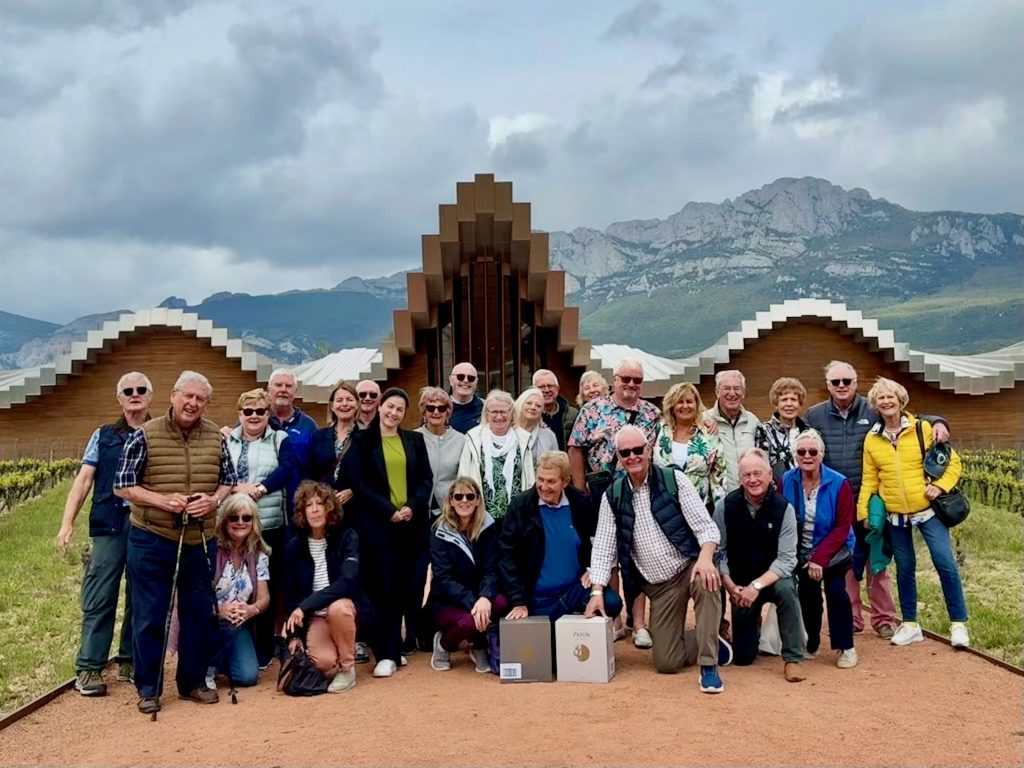
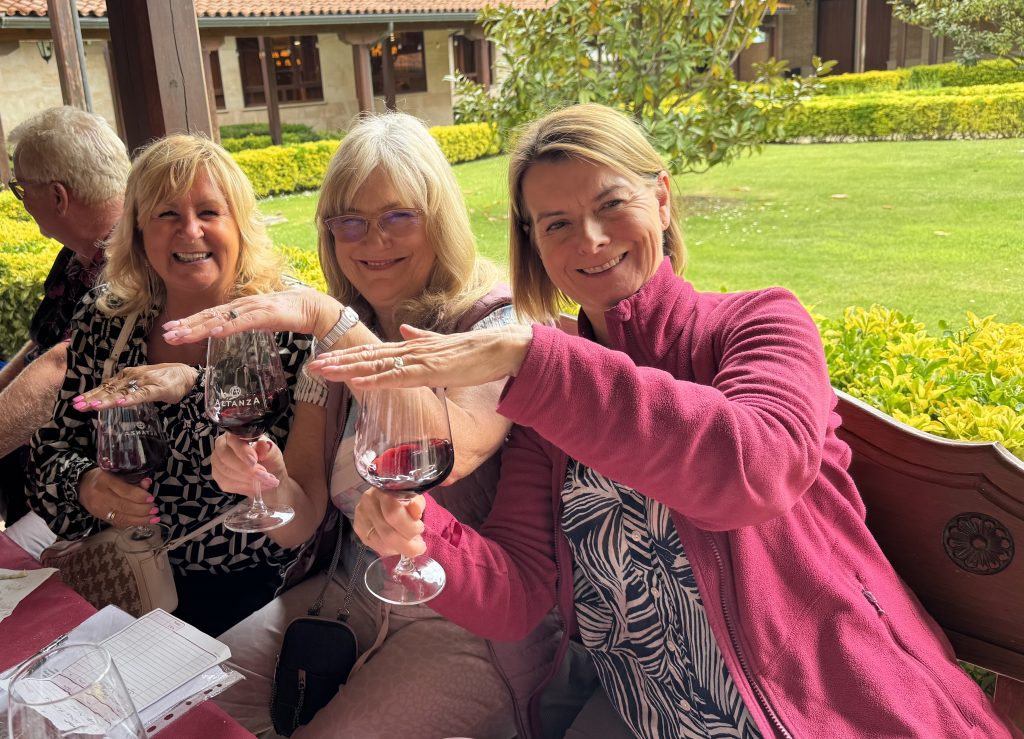

Our adventure took a group of new and seasoned CBWS members to the famous wine region of La Rioja.
La Rioja is in the north of Spain, in the Ebro River Valley. It is sheltered to the north by the Sierra de Cantabria Mountains and there are 3 distinct wine zones: Rioja Alta, Rioja Oriental and Rioja Alavesa.
Our visit was concentrated in the smallest zone of Rioja Alavesa, just north of the town of Logroño. Here vineyards are often found on small terraced plots of chalky/lime soils reaching into the foothills of the mountains. These mountains shield the vineyards from the north and help to create the drier climatic conditions for the grapes to flourish.
Logroño is an important centre for Rioja. It houses the offices of the Consejo Regulador, which controls the designation and standards of Rioja wine production.
The merry band of 29 wine loving souls gathered on 6 May at the Eurostars Fuerte Ruavieja Hotel in Logroño as the base for the stay. It proved an excellent spot both as a starting point for the various bodega tours and for exploring the town. We joined up in the hotel bar for the short walk to Restaurant El Palmeral for a welcome reception followed by dinner. The convivial atmosphere enabled members to connect, renew acquaintances or get to know each other.
Wednesday 7 May Day 1 proper of the trip started with a morning visit to Bodegas Vivanco in Briones. We were taken by a very smart black bus driven by the charming and skilful Saray.
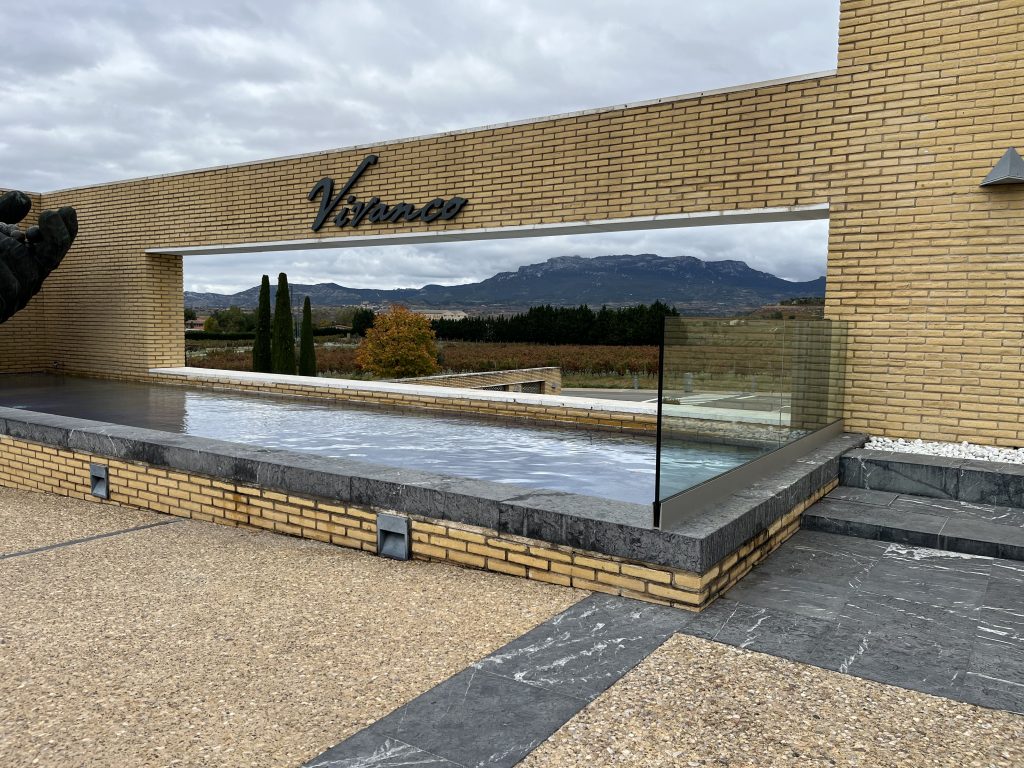
The bodega is in a beautiful setting on the edge of Briones; lush green hills, valleys and vineyards as far as the eye can see to the protecting cliffs of the Sierra Cantabria.
We were primarily visiting the Vivanco Museum in the bodega, which holds a thorough history of wine production, set out in different rooms. Each room depicts a different part of the process and is illustrated with objects such as huge wooden presses or barrels in the making. The first room holds displays vividly depicting the history of winemaking, its geography and geology. We saw too, the skills of the pickers, coopers, glass blowers and cork makers in fascinating videos of their traditional skills.
Additionally, the impact of wine in art was presented via artefacts, ceramics and pictures, including originals by Miro, Picasso, Warhol, Braque et al. The quirkiest room holds a collection of 3,000 corkscrews!
Two hours went by surprisingly quickly studying all the fascinating exhibits. The day then continued with a drive through the stunning, undulating countryside, passing numerous bodegas to the rural location of
Bodega Viñedos de Páganos (Sierra Cantabria Group) Páganos.
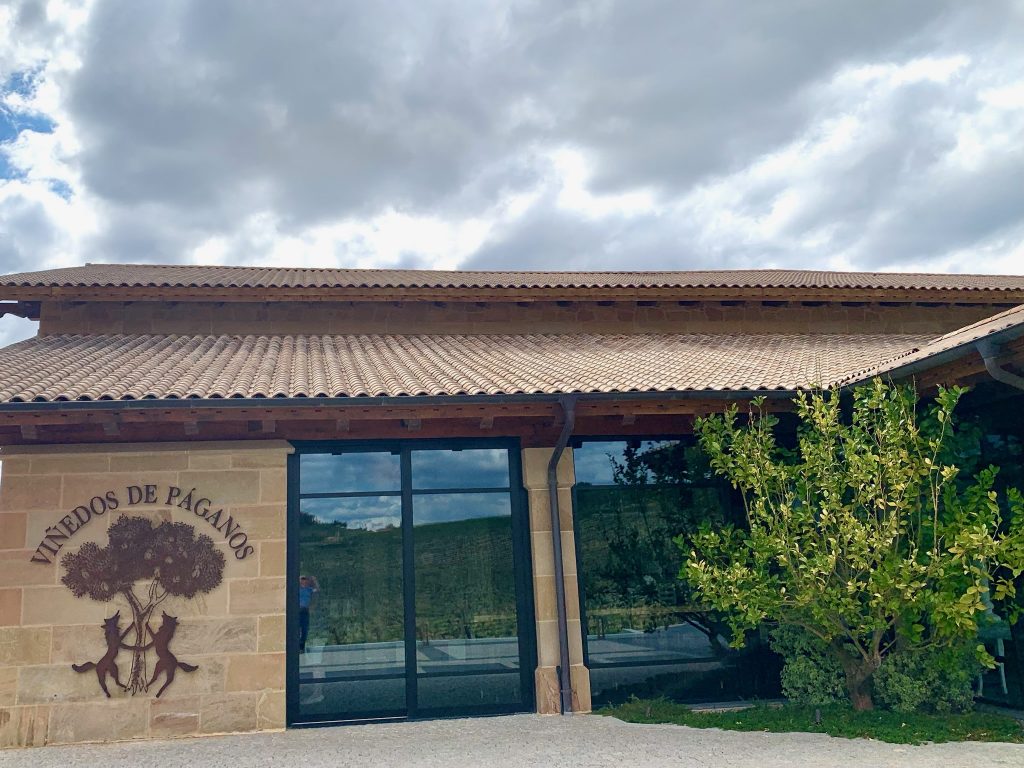
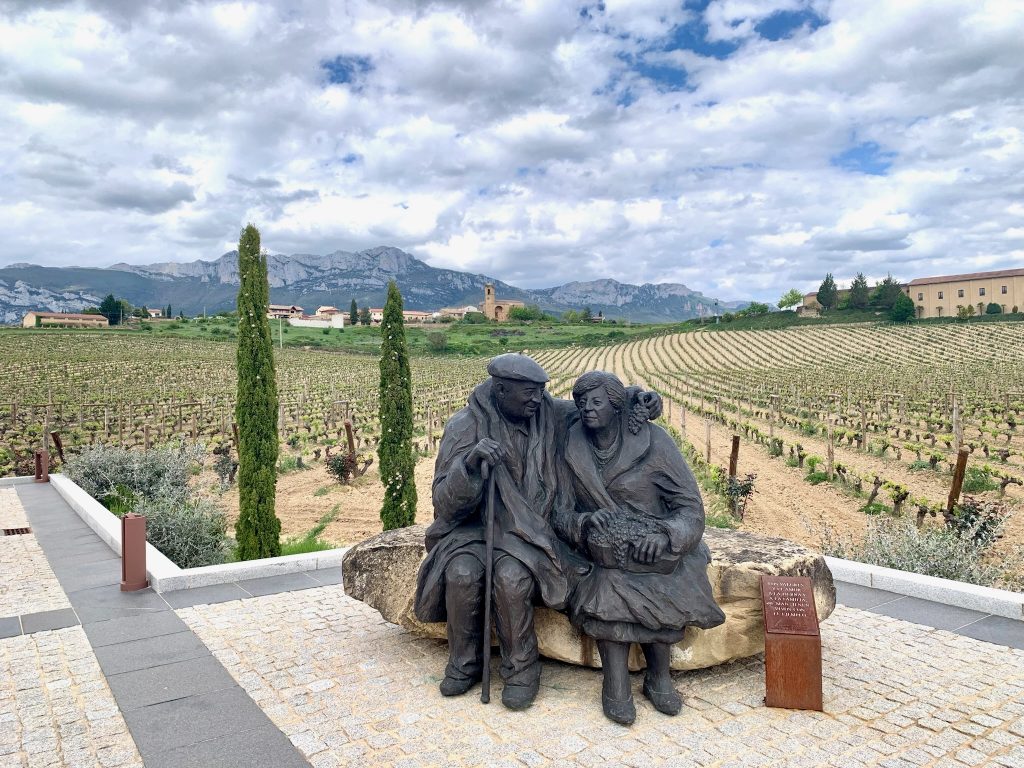
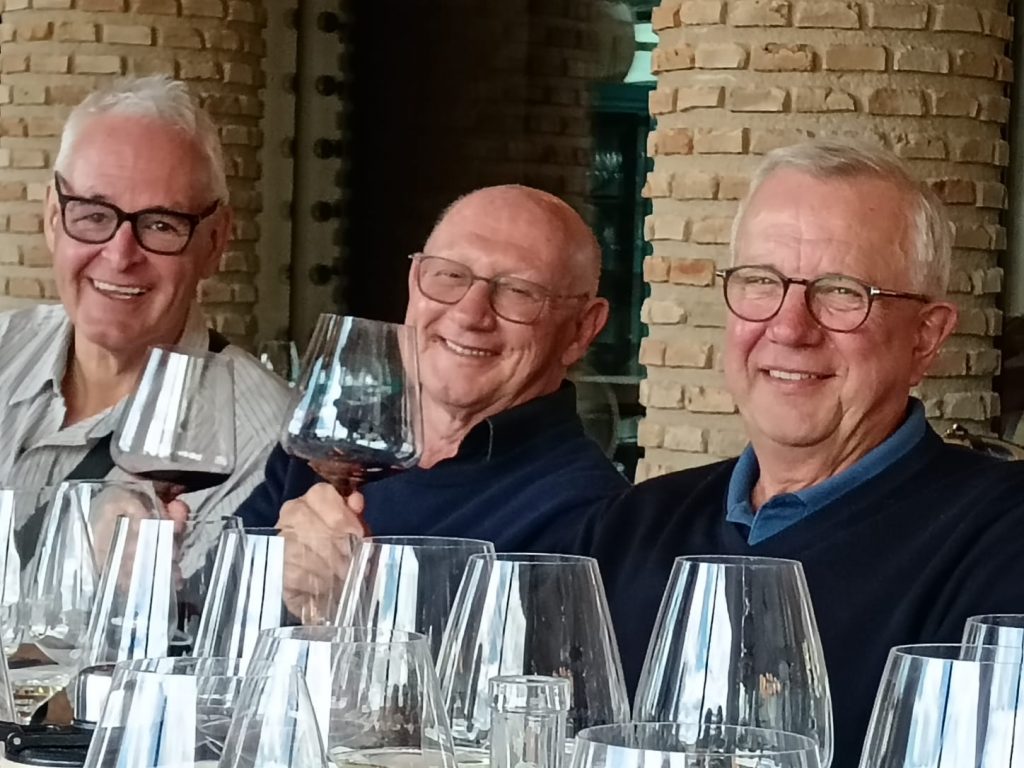
Bodegas Sierra Cantabria was founded by the Eguren family in 1870 and is known for its dedication to both traditional and innovative winemaking techniques. The winery produces a variety of high-quality wines in their 4 Rioja vineyards, primarily using Tempranillo grapes along with other local varieties. Viñedos de Páganos was established in 1998 in the small village of Páganos where they have created a subterranean bodega beneath the vineyards. It also houses the famous El Puntido restaurant.
Their meticulous production process, which includes both traditional methods, like manual de-stemming, together with modern techniques, ensures exceptional quality in every bottle. The Eguren family’s commitment to excellence has earned Bodega Sierra Cantabria a respected name in the world of wine.
Our host, Manuel, introduced us to the bodega. He showed us the individual parcels of vines that generate those grapes which are kept separate to produce distinct and distinctive wines. He took us outside through a heavy bolted door at the end of a rock corridor to show us a heart shaped vineyard which produces the grapes for their most expensive wine, La Nieta. Then we were led through the labyrinth of caves beneath the bodega. Hewn from the rock to create a perfect natural mix of darkness, dankness, constant temperature and humidity to store and mature the wine in barrels. Walls running with water and a chill in the air!
Following the tour, we were taken to the Restaurant El Puntido to taste samples of their output. We tried
Sierra Cantabria Blanco 2024
Sierra Cantabria Organza 2023
Calados de Puntido 2020
El Puntido 2021
Miguel’s humour and passion for the wine shone through. The tasting took us from a young fresh white through wines of increasing complexity and depth.
We were then treated to a delicious array of courses from the restaurant, accompanied by yet more examples of the wine.
Judging by the buzz and chatter along the table, the members enjoyed a most convivial afternoon.
A somewhat somnolent but satisfied coach load returned to the hotel.
In the evening, various of us explored the delights of central Logroño, especially Calle Laurel with its numerous tapas bars, many specialising in a single plate, mushrooms, calamari etc. A veritable moveable feast.
And so to bed.
DAY 2 Thursday 8 May
The morning visit saw us take the short journey to
Bodegas Olarra
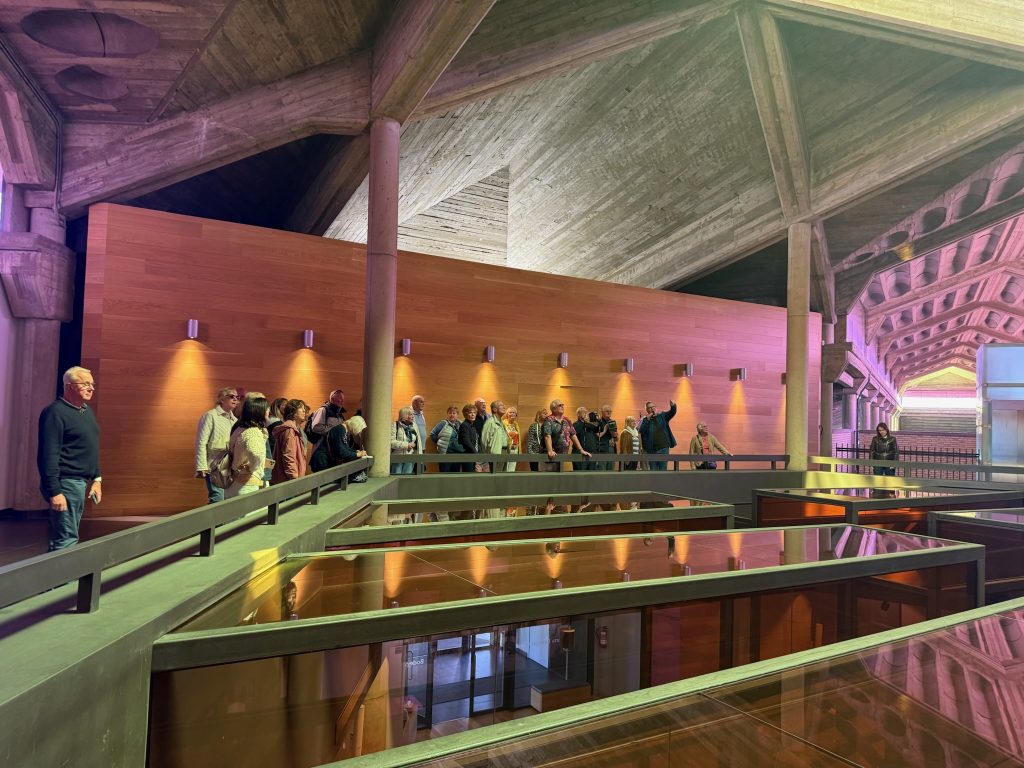
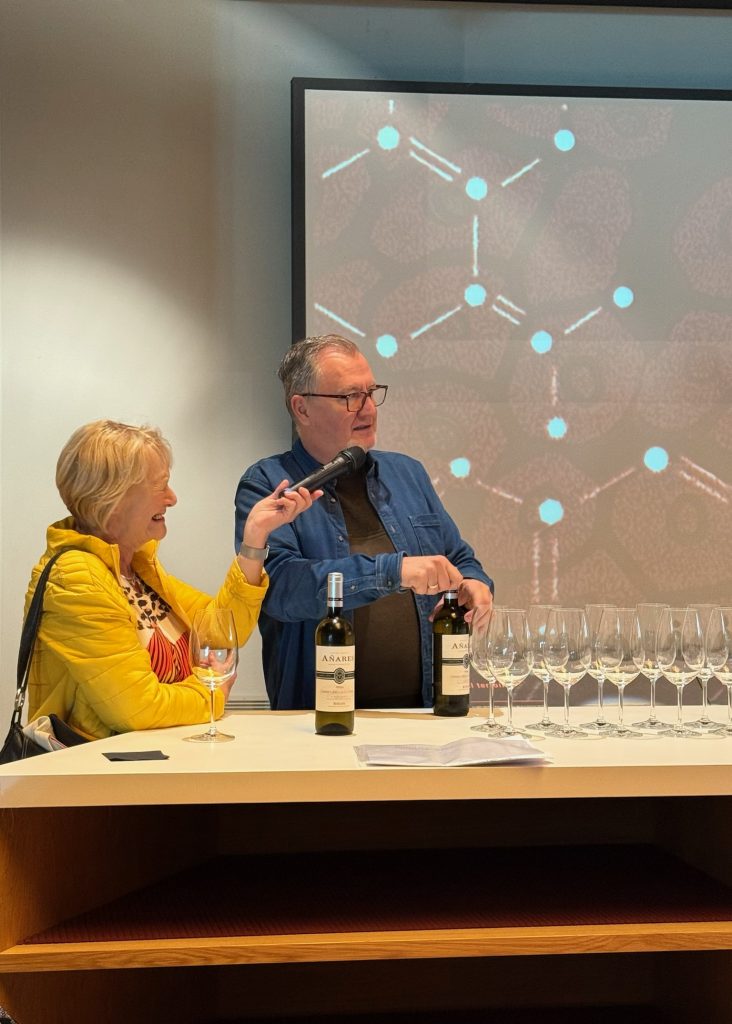

Bodegas Olarra is a distinguished winery known for its architectural grandeur and exceptional wines. Founded over 50 years ago, the winery is often referred to as the “Great Cathedral of Rioja” due to its stunning design by architect Juan Antonio Ridruejo, because it resembles a Gothic cathedral. Inside it is a rather austere, brutalist, concrete edifice of the late Franco era, built as a complete whole. The most startling aspect of the building are the 111 conical, red tiled roofs housing the maturing casks.
Bodegas Olarra focuses on producing high-quality wines using traditional methods adapted to modern times, with a strong emphasis on sustainability and the careful selection of raw materials. The winery is currently managed by the third generation of the Olarra family, who continue to uphold the winery’s philosophy of creating wines that reflect their heritage and the evolving tastes of consumers.
We were greeted by Jose, a winemaker and lecturer in oenology at the University of Rioja. In contrast to other Bodegas, Olarra makes wine on a carefully managed, industrial scale and size production. Grapes are sourced from over 200 growers in the vicinity of Logroño. Growers’ vines are tested regularly and they are told when to harvest and in what quantities. The grape varieties are mainly Tempranillo, Garnacha, Mazuelo and Graciano.
The wine making process follows the familiar pattern. Grapes are separated from vines by machines and loaded into large (7,500 litre steel then 1,500 litre concrete) vats macerated 4x daily. The wine is then transferred to oak barrels: American, French and a few from other European sources, and stored under the vast 111 roofed cellar, specially designed to optimise temperature and humidity.
The remaining must is sold off to other producers for distillation and the production of fortified wines and liqueurs.
After the tour we entered the tasting room. Jose offered some useful pointers and reminders on tasting, especially not taking cheese before wine as it tends to soften the flavour, giving a sometimes false impression of quality!
The wines tasted were:
Añares Blanco
Olarra Reserva
Olarra Gran reserva
These blended wines were certainly a celebration of the wine maker’s skill in contrast to the single varietals of the previous day.
We bade our farewells and took the coach out into the countryside again to visit
Bodegas Altanza
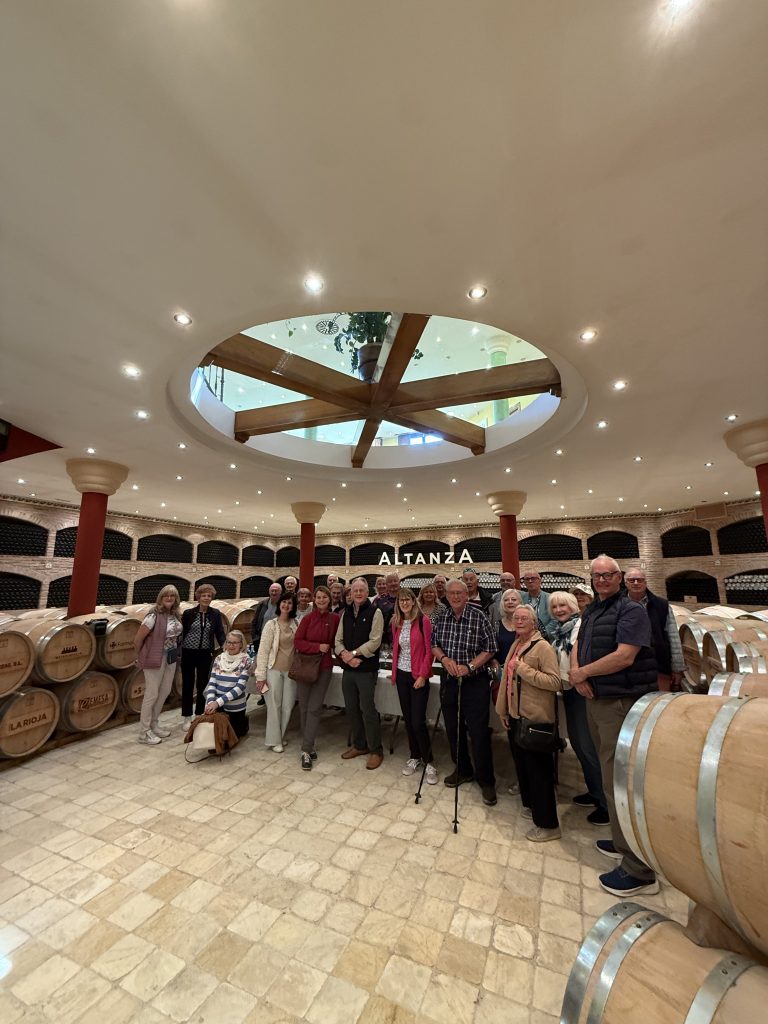
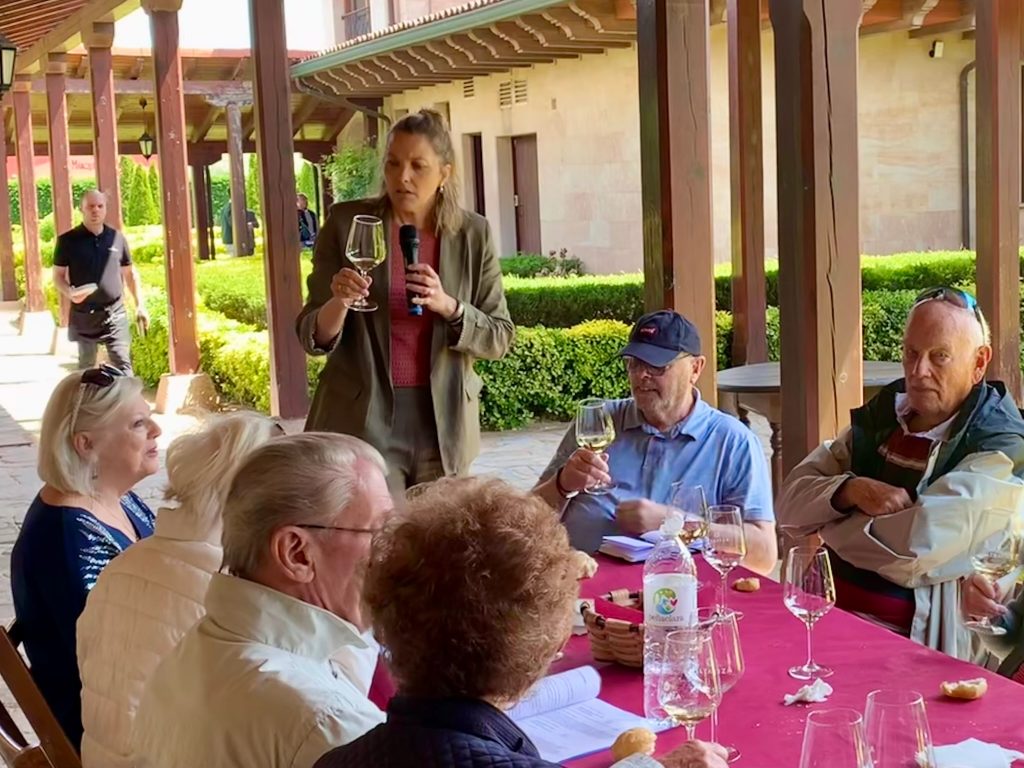

Altanza Bodega is a complete contrast to the very commercial, functional Olarra Bodega. Altanza’s buildings are soft peach-coloured in a traditional design. The bodega stands as a beacon of excellence in the world of winemaking. Founded in 1998 with the vision of producing high-quality wines that honour the region’s rich traditions, Altanza blends modern techniques with time-honoured practices. The bodega is renowned for its exceptional Tempranillo wines, which are crafted with meticulous care and a deep respect for the art of viticulture.
We arrived at the estate on the outskirts of Fuenmayor to see welcoming buildings nestled in beautiful, manicured gardens. We were greeted by Stephanie, who proved to be a lively, knowledgeable and humorous host. She outlined the growth of Altanza from 1998, indicating the small scale of output (about 1 million bottles per year). The estate is a collaboration of 5 families. The wine production process is mechanised, but the driving force is the quality of the grapes, the vast majority of which are sourced from their own vineyards.
Part of the marketing of the wines involved using classic Spanish art to adorn the labels, from Valesquez, Goya, Gaudi, Miro, Dali and Sorolla. This has proved to be a double-edged sword, as for example, Velasquez and Goya nudes don’t go down well in either the Arab states or USA!!
The tour of the winemaking facilities was enhanced both by the simple, stylish design of the building and Stephanie’s informative, concise explanations of a process with which she realised we were already familiar! They mature the wine in mainly French oak for 12 months for a Crianza and 18 months for a Reserva. An interesting fact was the demonstration with part of a wine barrel to show that the inside of the barrel is scraped after 8 years to open up the pores and release the oak flavour.
We tasted 4 wines:
Alma Bohemia – rosado
Altanza Sauvignon Blanc 2024
Crianza Edulis 2021
Altanza Reserva 2019
Then we were generously treated to a fifth by Roelof and Katarina Winter, two of our fellow tasters
Altanza Gran Reserva 2016
To the writers’ palates these wines were all very drinkable and extremely good value.
Another satisfied coach load of tasters returned to the hotel, many for a siesta before venturing out into the town to explore more tapas bars or in the writers’ case a restaurant called ‘La Cocina de Ramon’ recommended by Tim and. Sandy. An unusual set up with rooms created by curtains to effect intimate spaces. Very attentive service and good food.
DAY 3 Friday 9 May
Bodegas Eguren Ugarte

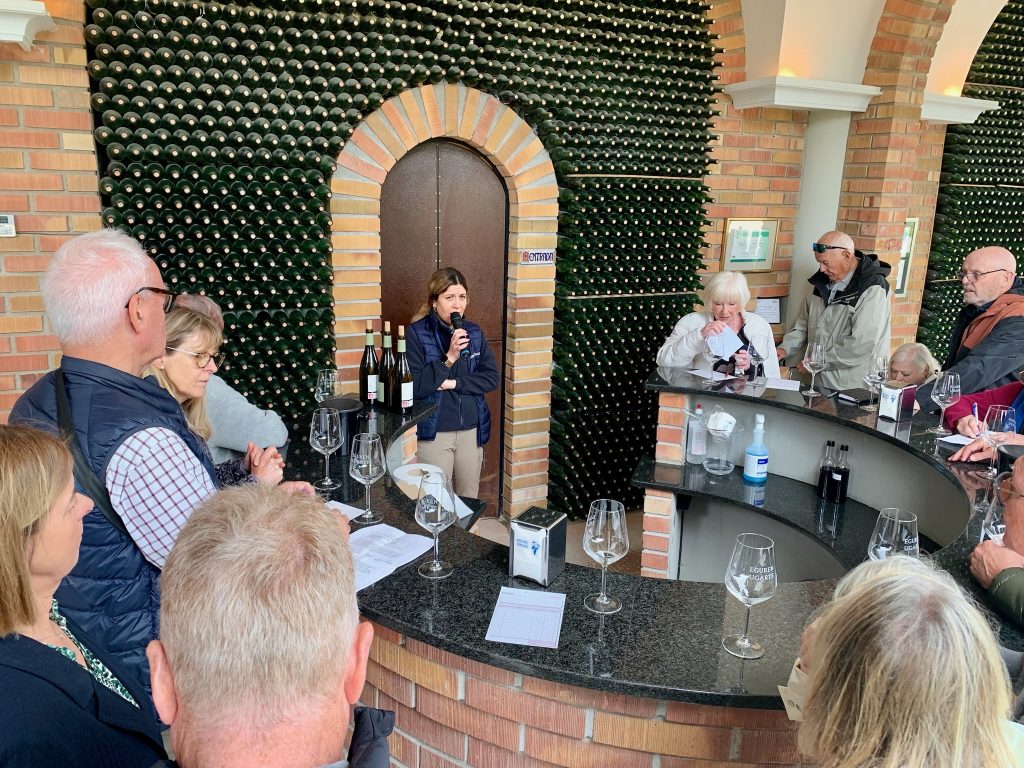
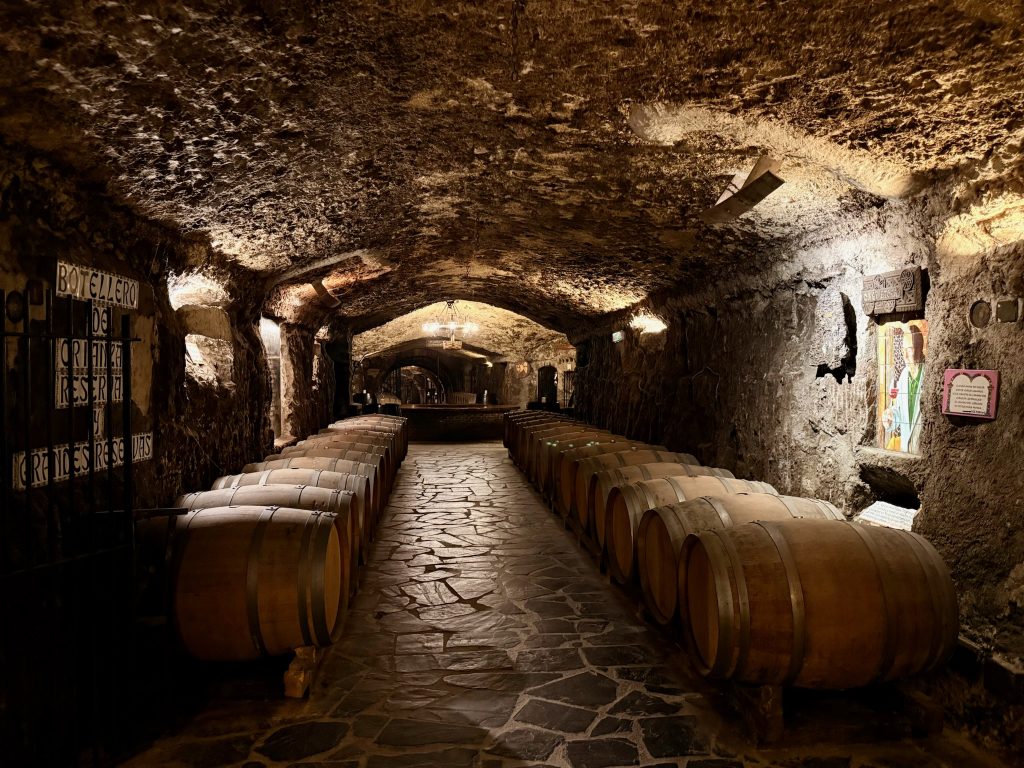
Surrounded by the imposing countryside, the vineyards of Eguren Ugarte are stretched over different patches of land throughout Laguardia. Fifty-year-old grapevines are located in Labastida and Páganos, a region perfect for the production of various vines including top quality Tempranillo, Garnacha, Graciano, Graciano, Maturana, Garnacha Blanca, Tempranillo Blanco, Malvasia, Viura, Sauvignon Blanc and Chardonnay. Asunción and Mercedes, the sixth generation of the Eguren family, are the present owners of Eguren Ugarte Winery and they believe in the manual picking of grapes and using only carefully chosen bunches to produce quality red, white and rosé wines from 130 hectares of vines.
It is a winery buried in the ground in 2,000 metres of caves, pioneered and cut out of the rock by Vitorino, the fifth generation of the Eguren family. In 1984, he established the caves for this winery in Laguardia, the heart of Rioja Alavesa. In 1987, Vitorino became the first bodega owner to organize tours of the caves and the winery, a practice which is now accepted as part of the wine experience for visitors to bodegas.
Our guide for the exploration of the caves was Sylvia, who was very knowledgeable. She took us first through rocky corridors, glistening damp in the low light and lined with steel bar gated niches containing boxes of wine. You can join the Niche Club, rent a niche and have your wine stored at the optimum temperature and humidity. The Club will also provide facilities for you to host a Txoko, a lunch or dinner in the caves, either catered by them or taking your own food. You can also have your wedding in the romantically lit caves as our guide Sylvia had done. Though I must say I think you might need a fur jacket!
Some connoisseurs buy a French oak barrel of wine containing 300 bottles and leave it to age in the cave. Quite a party when they start drinking it, I imagine!
In 2014, to celebrate Vitorino’s 80th birthday, the tempranillo grapes from 80 year old vines were gathered and fermented for 10 days. It then spent 12 months in new American oak barrels and was not clarified or filtered before spending a minimum of 16 months in the bottle.
The wines we tried:
Tempranillo Blanco 2022
Maturana 2019
Eguren Ugarte Reserva 2017
And so, after more purchases, our dedicated band, united by a love of wine and the ability to quaff at 11am, took our seats in the big coach for the short trip to the last tasting experience on this trip.
Bodegas Ysios
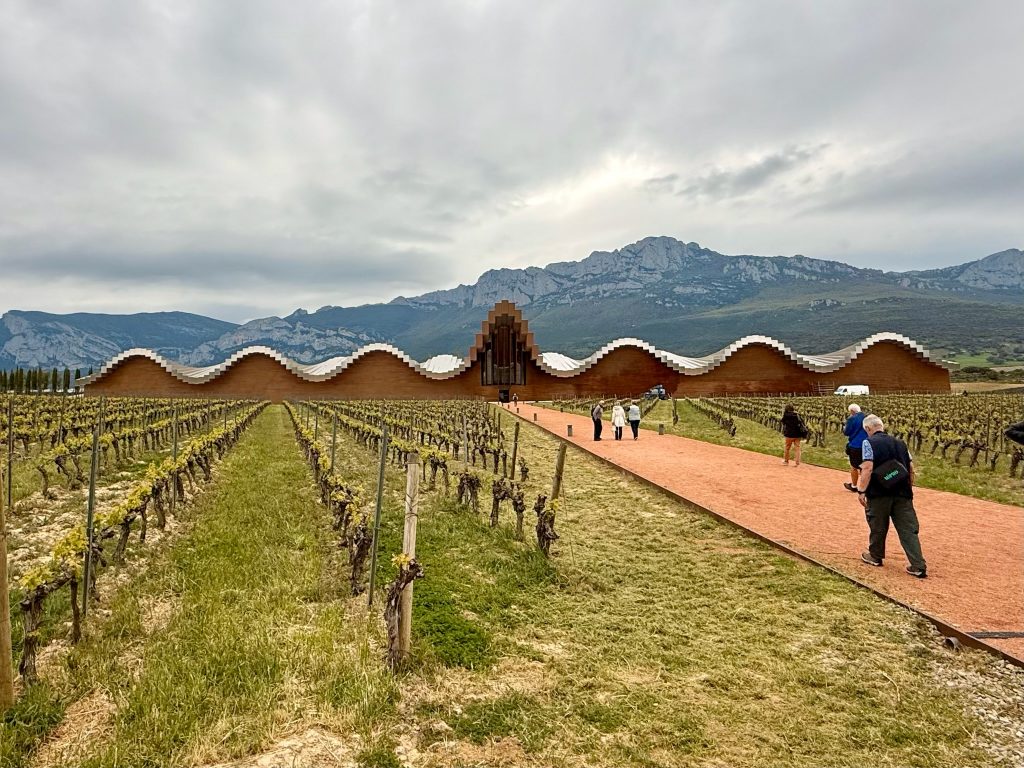
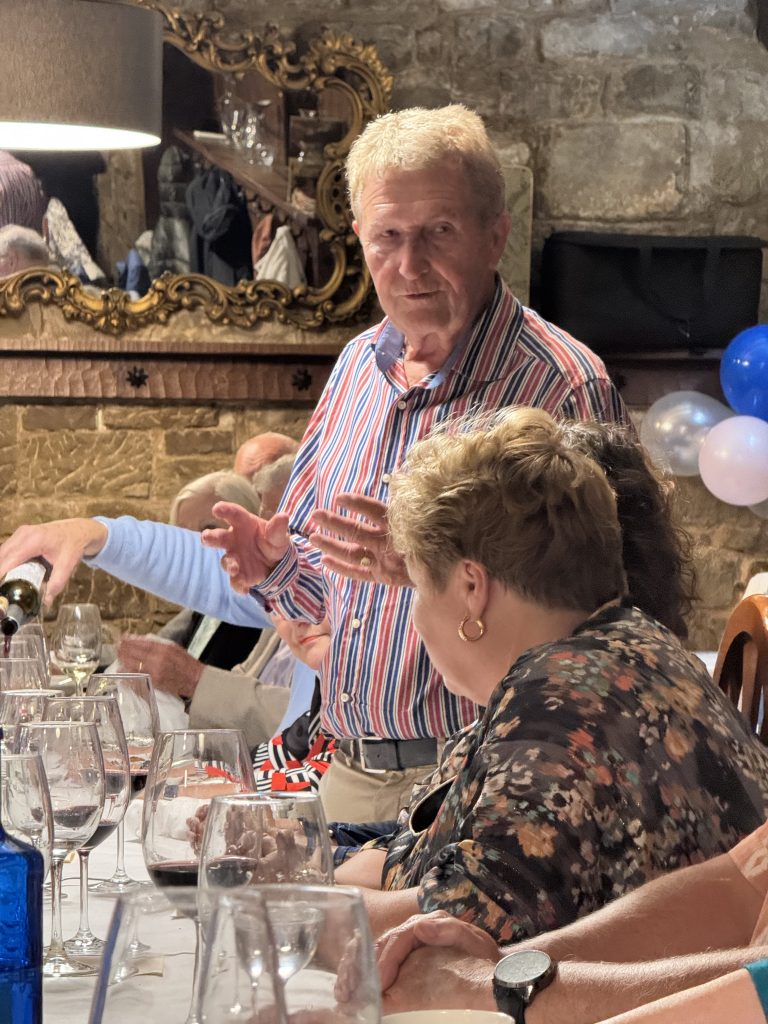
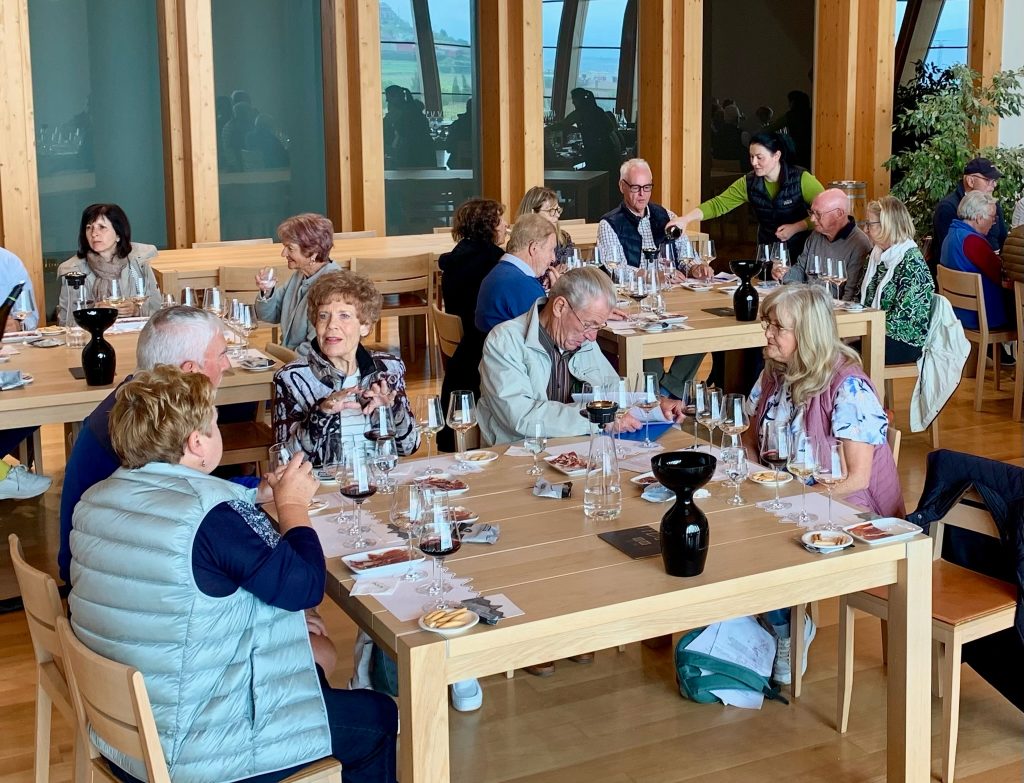
If you visit Laguardia and stand on the lookout point, you will be looking down on the distinctive outline of the undulating roof of Bodegas Ysios. The most dramatic building of the trip, designed by Santiago Calatrava, it opened in 2001. The winery became part of the Pernod Ricard group in 2014 and more recently was sold to Australian wine giant Accolade Wines. It focuses on producing very high quality wine. The name Ysios is a tribute to the Egyptian gods Isis and Osiris and is memorably different!
Our guide for this tour was Rachel. She explained everything very clearly and succinctly, mirroring the clean lines of the antiseptic stainless steel tanks. There are 35 hectares of vines with 50 plots. However, Ysios only owns 2, the rest are contracted. The grapes are almost exclusively Tempranillo on old vines from 40 to 100 years old, so they produce fewer grapes of a much higher quality. The winemaker, Clara Canals, selects the plots to be harvested and the grapes are carefully collected by hand to avoid any unnecessary bruising. The grapes from the different plots are kept separate in the tanks and in the barrels and then blended. The anomalies in the fermenting room were the clay amphora containing the white wine, looking decidedly out of place in the pristine smoothness. The wines are aged in French oak barrels, which are only used 4 times, each time for 14/15 months, except for the white wine which is kept in concrete. Rachel informed us that the Laguardia wine was the only one left with the lees to intensify the flavour. Ysios’ signature wine is the Finca Las Naves retailing for €150 from the bodega, with under 4,000 bottles per year. In fact, Ysios wines can only be bought from the bodega. The stock is limited to approximately 100,000 to 180,000 bottles per year. There are 4 colours of labels to denote the different types: red for Crianza, brown for Reserva, purple for Gran Reserva and green for the Collection signature wines.
Wines we tasted in the gallery above the cask room with a stunning view of the town of Laguardia on the hill:
Ysios Blanco 2020
Ysios Rosé
Ysios Seleccion 2016
It was a fitting ending to our tasting – experiencing the high end of the winemaker’s craft.
We wended our way back to Logroño for a well-earned rest before the evening’s farewell drinks and dinner.
We met in the hotel bar and walked the short distance to Café Moderno – surely an oxymoron we thought as the café was established in 1916! Outside there was a red beret band and a group in blue uniforms, maybe religious. Inside it felt very old traditional Spanish as the wine flowed around the tables – white and red Ruiz de Viñaspre.
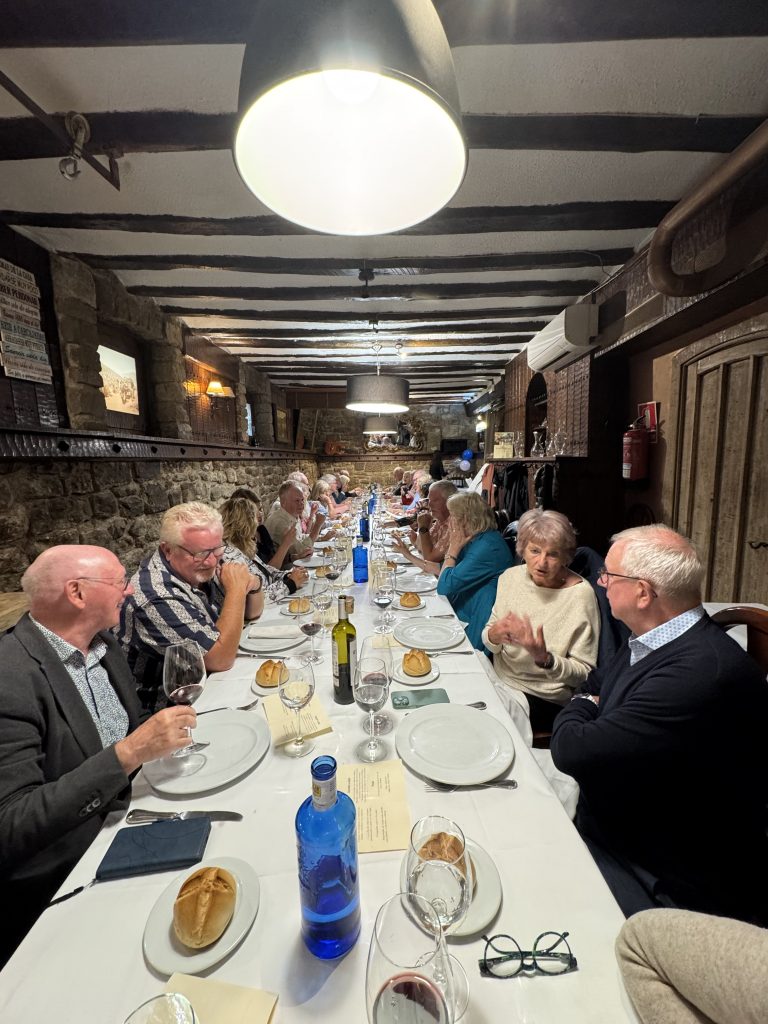
Another short walk and we reached the Restaurante Rincon del Vino, where we were ensconced in a long room, again very traditional and welcoming. The manager of the restaurant and her waitresses worked very hard to make sure we were served quickly and efficiently. The food was delicious, produced by a smiling and relaxed cocinero, despite the numbers.
Neville Richardson, our President in his sum up speech, expressed a sentiment felt by all, that this had been a splendid trip
As we wended a weary way back to our hotel, we reflected on how fitting a farewell it was to a wonderful time.
Special mention must go to the organisers, Sandy and Tim Fawle, Shirley and John Sloggie for their outstanding planning, selection and organisation of the whole trip. John’s commanding presence, as chief whipper in, ensured that we got where we needed to be on time. Their attention to detail made for a relaxed and thoroughly enjoyable experience.
Thanks too to the participants for their company, for sharing their diverse life experiences, united by a common thread, the love of wine.
Further images can be found on our gallery page
Report compiled by
Caroline Swain
Richard Harris